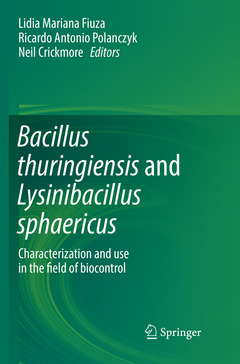Description
Bacillus thuringiensis and Lysinibacillus sphaericus, Softcover reprint of the original 1st ed. 2017
Characterization and use in the field of biocontrol
Coordinators: Fiuza Lidia Mariana, Polanczyk Ricardo Antonio, Crickmore Neil
Language: English
Subjects for Bacillus thuringiensis and Lysinibacillus sphaericus:
Publication date: 08-2018
Support: Print on demand
Publication date: 06-2017
Support: Print on demand
Description
/li>Contents
/li>Biography
/li>Comment
/li>
This volume presents a comprehensive perspective of the biopesticides Bacillus thuringiensis and Lysinibacillus sphaericus, from their basic biology to agriculture, forestry and public-health applications. It covers their ecology, virulence factors, and genetic characterization. The topics related to agriculture and forestry include mode of action, receptors of insect pests, and heterologous expression of toxins in insect cells and plants. Public-health researchers will find information on vector control programs with an emphasis on the Neotropical region. The book also discusses new products and the global market.
Foreword
Lidia Mariana Fiuza, Ricardo Polanczyk and Neil Crickmore (Editors of the book)
Preface
Leon Rabinovitch
Leon Rabinovitch, Vilmar Machado, Neiva Knaak, Diouneia Lisiane Berlitz, Ricardo Polanczyk and Lidia Mariana Fiuza
Chapter 2. The biology, ecology and taxonomy of Bacillus thuringiensis and related bacteria
Ben Raymond
Chapter 3. Bacillus thuringiensis toxin classification
Neil Crickmore
Chapter 4. Insecticidal proteins from Bacillus thuringiensis and their mechanism of action
Alejandra Bravo, Sabino Pacheco, Isabel Gómez, Blanca Garcia-Gómez, Janette Onofre and Mario Soberón
Chapter 5. Effect of Bacillus thuringiensis on parasitoids and predators
Sergio Antonio De Bortoli, Alessandra Marieli Vacari, Ricardo Antonio Polanczyk, Ana Carolina Pires Veiga and Roberto Marchi Goulart
Fernando Hercos Valicente and Rosane Bezerra da Silva
Chapter 7. New sequencing technologies and genomic analysis applied to Bacillus thuringiensis
Roberto Franco Teixeira Correia, Anne Caroline Mascarenhas dos Santos, Raimundo Wagner de Souza Aguiar, Bergmann Morais Ribeiro and Fernando Lucas Melo
Chapter 8. Expression of Bacillus thuringiensis in insect cells
Bergmann Morais Ribeiro, Érica Soares Martins, Raimundo Wagner de Souza Aguiar and Roberto Franco Teixeira Correia
Chapter 9. Bacillus thuringiensis: Different Targets and Interactions
Lidia Mariana Fiuza, Diouneia Lisiane Berlitz, Jaime Vargas de Oliveira and Neiva KnaakChapter 10. Specificity and cross-order activity of Bacillus thuringiensis pesticidal proteins
Kees van Frankenhuyzen
Chapter 11. The American Bacillus thuringiensis based biopesticides market
Ricardo Antonio Polanczyk, Kees van Frankenhuyzen and Giuliano PauliChapter 12. Mass production, application, and market development of Bacillus thuringiensis Biopesticides in China
Lin Li, Zhenmin Chen and Ziniu Yu
Rose Gomes Monnerat, Glaucia de Figueiredo Nachtigal, Ivan Cruz, Wagner Bettiol and Clara Beatriz Hoffman Campo
Chapter 14. Bacillus entomopathogenic based biopesticides in vector control programs in Brazil
Clara Fátima Gomes Cavados, Wanderli Pedro Tadei, Rosemary Aparecida Roque, Lêda Narcisa Regis, Claudia Maria Fontes de Oliveira, Helio Benites Gil and Carlos José Pereira da Cunha de Araujo-Coutinho
Chapter 15. Resistance of mosquitoes to entomopathogenic bacterial based larvicides: current status and strategies for management
Maria Helena Neves Lobo Silva-Filha
Chapter 16. The importance of Bacillus thuringiensis in the context of genetically modified plants in Brazil
Deise Maria Fontana Capalbo and Marise Tanaka SuzukiChapter 17.Resistance of Spodoptera frugiperda to Bacillus thuringiensis proteins inin the Western Hemisphere
Samuel Martinelli, Renato Assis de Carvalho, Patrick Marques Dourado and Graham Phillip HeadDr. Lidia Mariana Fiuza – PhD (ENSAM-Montpellier/France), is currently Researcher at Instituto Riograndense do Arroz (IRGA) and member of the Agricultural Sciences Commitee at Research Foundation of Rio Grande do Sul, Brazil. She specializes in the areas of toxicology, microbiology, and entomology, with an emphasis in bacteriology and acting on the following topics: Bacillus thuringiensis and correlates; genes cry; insecticidal proteins; plants-Bt; toxin interactions; microbial control of pests and diseases. As innovation and technology activities, she is a partner in the Control_Agro_Bio Pesquisa e Defesa Agropecuária Ltda., which is currently accredited in the Brazilian Ministry of Agriculture as a Collaborating Center for Pest Risk Analysis – ARP, Section of Agricultural Defense, Department of Plant Protection.
Dr. Ricardo Antonio Polanczyk – PhD (ESALQ/USP), is currently Assistant Professor at UNESP. Before this, he was at UFES, working with Dr. Pratissoli in IPM systems. Microbial control of agricultural pests is his main field of research, including the interactions between microbial control agents and pesticides and Bt plants. In 2014 he took part in the course "Risk Analysis: Role of Science in GMO Decision-making" in the International Centre for Genetic Engineering and Biotechnology (Trieste- Italy).
Dr. Neil Crickmore – PhD (University of Warwick), is currently Senior Lecturer in Molecular Genetics, University of Sussex and Adjunct Professor State Key Laboratory for the Biology of Plant Diseases and Insect Pests, Institute of Plant Protection, Chinese Academy of Agricultural Sciences, Beijing, China. Before, he was Research Associate at University of Cambridge. Widely heralded today as a leading figure in Bacillus thuringiensis research. Chair and webmaster of International Bacillus thuringiensis toxin nomenclature committee; Convenor of the Bacterial Division of the IOBC/WPRS.<
Describes the physiology, biochemistry, and molecular biology of Bacillus thuringiensis and Lysinibacillus sphaericus
Provides information for agroforestry applications, such as mode of action, receptors of insect pests, and heterologous expression of toxins in insect cells and plants
Covers public health concerns, including vector control programs with an emphasis on the Neotropical region
Discusses the global market and the development and registration of new products
Includes supplementary material: sn.pub/extras




